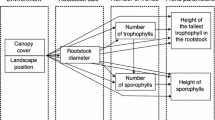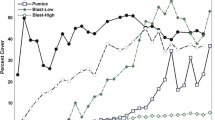Abstract
Equilibrium theory predicts that after disturbance, ecosystemseventually regain the structural and functional properties characteristic oftheir predisturbance condition. This study tested this idea by examining theeffects of cattle grazing and exclusion on the long-term structuralcharacteristics of sedge meadows in southern Wisconsin. To compare structuralchanges in mean percentage cover and height, repeated measures analysis wasconducted on two sedge meadows over a twenty year period from 1977 to 1997. Onesedge meadow was recovering from cattle grazing (cattle excluded in 1973) andthe other was a reference area (nearly undisturbed). Both of these study siteschanged structurally from 1977 to 1997, supporting non-equilibrium theory.Additional observations were made in a heavily and lightly grazed sedge meadowthat were surveyed in 1977. As based on the positions of subunits in anordination graph produced using Non-Metric Multidimensional Scaling (NMS), therecovery sedge meadow became less structurally similar to the grazed and moresimilar to the reference site over the 20 year study. However, from theperspective of mean maximum height in another NMS analysis, the recovery sedgemeadow became less similar to the reference site over time likely because by1997, a shrub carr of Cornus sericea had developed in therecovery sedge meadow that had been dominated by graminoids and forbs in 1977(mean maximum height: 1977 vs. 1997; 0 vs. 47 cm). Seedlings ofCornus sericea were invading the grazed sedge meadows andin the recovery sedge meadow (cattle excluded 4 years earlier) in 1977. A shrubcarr did not develop in the reference sedge meadow. Changes in the referencesite were relatively minor over this time interval; certain species eitherincreased or decreased in dominance, e.g., Carex strictaincreased in cover (1977 vs. 1997, 20 and 28 mean percentage (%) cover,respectively). A few short-term species of the recovery sedge meadow followedthe tenets of equilibrium theory. These became less common or disappeared4–9 years after cattle exclusion including Asterlanceolatus, Calamagrostis canadensis,Poa compressa, Solidago altissima andVerbena hastata. Some of these species were eaten andlikely spread by the cattle. This study suggests that the progression of sedgemeadow to shrub carr may not be an inevitable outcome of succession but insteadcan be a consequence of past cattle grazing history. Also, because the recoveryand the reference sedge both changed structurally over time, the tenets ofnon-equilibrium theory were supported by this study.
Similar content being viewed by others
References
Andrew M.H. 1988. Grazing impact in relation to livestock watering points. Trends in Ecology and Evolution 3: 336–339.
Barrat-Segretain M.H. 1996. Strategies of reproduction, dispersion, and competition in river plants: a review. Vegetatio 123: 13–37.
Baskin J.M. and Baskin C.C. 1980. Ecophysiology of secondary dormancy in seeds of Ambrosia artemisiifolia. Ecology 61: 475–480.
Bedford B.L., Zimmerman E.H. and Zimmerman J.H. 1974. The Wetlands of Dane County, Wisconsin. Dane County Regional Planning Commission, Madison, Wisconsin.
Bowles M., McBridge J., Stoynoff N. and Johnson K. 1996. Temporal changes in vegetation composition and structure in a fire-managed prairie fen. Natural Areas Journal 16: 275–288.
Cairns J. and Pratt J.R. 1995. Ecological restoration through behavioral change. Restoration Ecology 3: 51–53.
Case R.L. and Kauffman J.B. 1997. Wild ungulate influences on the recovery of willows, black cottonwood and thin-leaf alder following cessation of cattle grazing in northeastern Oregon. Northwest Science 71: 115–126.
Chapin F.S., Torn M.S. and Tateno M. 1996. Principles of ecosystem sustainability. The American Naturalist 148: 1016–1037.
Clary W.P. 1995. Vegetation and soil responses to grazing simulation on riparian meadows. Journal of Range Management 48: 18–25.
Cook C.D.K. 1987. Dispersion in aquatic and amphibious vascular plants. In: Crawford R.M.M. (ed.), Plant Life in Aquatic and Amphibious Habitats. Special Publication Number 5 of the British Ecological Society Blackwell Scientific Publications, Oxford, pp. 179–190.
Cook G.D., Setterfield S.A. and Maddison J.P. 1996. Shrub invasion of a tropical wetland: implications for weed management. Ecological Applications 6: 531–537.
Costello D.F. 1936. Tussock meadows in southeastern Wisconsin. Botanical Gazette 97: 610–648.
Curtis J.T. 1971. The Vegetation of Wisconsin. University of Wisconsin Press, Madison, Wisconsin.
Dumortier M., Verlinden A., Beeckman H. and van der Mijnsbrugge K. 1996. Effects of harvesting dates and frequencies on above and below-ground dynamics in Belgian wet grasslands. Ecoscience 3: 190–198.
Ellison L. 1960. Influence of grazing on plant succession of rangelands. The Botanical Review 26: 1–78.
Fenner M. 1985. Seed ecology. Chapman and Hall, London.
Fleischner T.L. 1994. Ecological costs of livestock grazing in western North America. Conservation Biology 8: 629–644.
Gleason H.A. and Cronquist A. 1991. Manual of Vascular Plants of Northeastern United States and Adjacent Canada. New York Botanical Garden, Bronx, New York.
Grant S.A., Torvell L., Smith H.K., Suckling D.E., Forbes T.D.A. and Hodgson J. 1987. Comparative studies of diet selection by sheep and cattle: blanket bog and heather moor. Ecology 75: 947–960.
Grime J.P. 1998. Benefits of plant diversity to ecosystems: immediate, filter and founder effects. Journal of Ecology 86: 902–910.
Hansen K. and Jensen J. 1993. Recolonization of experimentally bared soil in a grazed common in Denmark. Nordic Journal of Botany 13: 431–440.
Hosner J.F. and Boyce S.G. 1962. Tolerance to water saturated soil of various bottomland hardwoods. Forestry Science 8: 180–186.
Hurlbert S.H. 1984. Pseudoreplication and the design of ecological field experiments. Ecological Monographs 54: 187–211.
Hutnik R.J. and Yauney H.W. 1965. Red maple (Acer rubrum L.). In: Fowells H.A. (ed.), Silvics of Forest Trees of the United States. U.S.D.A. agricultural handbook United States Department of Agriculture, Washington, D.C., pp. 57–62.
Jackson H.H.T. 1961. Mammals of Wisconsin. The University of Wisconsin Press, Madison, Wisconsin.
Johansson M.E. and Nilsson C. 1993. Hydrochory, population dynamics and distribution of the clonal aquatic plant Ranunculus lingua. Journal of Ecology 81: 81–91.
Jutila H.M. 1997. Vascular plant species richness in grazed and ungrazed coastal meadows, SW Finland. Ann. Bot. Fennici 34: 245–263.
Kauffman J.B., Case R.L., Lytjen D., Otting N. and Cummings D.L. 1995. Ecological approaches to riparian restoration in northeast Oregon. Restoration and Management Notes 13: 12–15.
Kie J.G. and Boroski B.B. 1996. Cattle distribution, habitats, and diets in the Sierra Nevada of California. Journal of Range Management 49: 482–488.
Kirk R.A. 1995. Experimental Design: Procedures for the Behavioral Sciences. 3rd edition. Brooks/Cole, Pacific Grove, California.
Kimura D. 1985. Feral cattle (Bos taurus) on Kuchinoshima Island, southwestern Japan: their stable ranging and their unstable grouping. Journal of Ethology 3: 39–47.
Liegel K. 1988. Land use and vegetational change on the Aldo Leopold Memorial Reserve. Transactions of the Wisconsin Academy of Sciences, Arts and Letters 76: 47–68.
Leck M.A. and Graveline K.J. 1979. The seed bank of a freshwater tidal marsh. American Journal of Botany 66: 1006–1015.
Malo J.E. and Suárez F. 1995. Establishment of pasture species on cattle dung: the role of endozoochorous seeds. Journal of Vegetation Science 6: 169–174.
Manly B., McDonald L. and Thomas D. 1993. Resource Selection by Animals. Chapman and Hall, London.
Martin L. 1932. The physical geography of Wisconsin. Geological Natural History Survey Bulletin 36, Madison, Wisconsin.
McCune B. and Mefford M.J. 1999. PC-ORD. Multivariate Analysis of Ecological Data, MjM Software Design, Gleneden Beach, Oregon.
McKnight J.S. 1965. Black willow (Salix nigra Marsh.). In:, Silvics of Forest Trees of the United States. USDA Agricultural Handbook United States Department of Agriculture, Washington, D.C., pp. 650–652.
McKnight J.S., Hook D.D., Langdon O.G. and Johnson R.L. 1981. Flood tolerance and related characteristics of trees of the bottomland forest of the southern United States. In: Clark J.R. and Benforado J. (eds), Wetlands of Bottomland Hardwood Forests, Proceedings of a Workshop on Bottomland Hardwood Wetlands of the Southeastern United States. Elsevier Scientific Publishing Company, Amsterdam, pp. 29–69.
Meredith T.C. 1985. Factors affecting recruitment from the seed bank of sedge (Cladium mariscus) dominated communities at Wicken Fen, Cambridgeshire, England. Journal of Biogeography 12: 463–472.
Middleton B.A. 1978. Vegetational response to grazing in the Lodi Wildlife Area. Senior, University of Wisconsin, Madison (unpublished).
Middleton B.A. 1995. The Role of Flooding in Seed Dispersal: Restoration of Cypress Swamps Along the Cache River, Illinois. Research Report 220, November 1995, U.S. Geological Survey and Water Resources Center, Champaign, Illinois.
Middleton B.A. 1998. The Water Buffalo Controversy in the Keoladeo National Park, India. Ecological Modelling 106: 93–98.
Middleton B.A. 1999. Wetland Restoration, Flood Pulsing and Disturbance Dynamics. John Wiley and Sons, New York.
Middleton B.A., van der Valk A.G., Mason D.H., Williams R.L. and Davis C.B. 1991. Vegetation dynamics and seed banks of a monsoonal wetland overgrown with Paspalum distichum in northern India. Aquatic Botany 40: 239–259.
Middleton B.A. and Mason D.H. 1992. Seed herbivory by nilgai, feral cattle, and wild boar in the Keoladeo National Park, India. Biotropica 24: 538–543.
Moran R.C. 1981. Prairie fens in northeastern Illinois: floristic composition and disturbance. In: Stuckey R.L. and Reese K.J. (eds), The Prairie Peninsula-In the Shadow of “Transeau”: Proceedings of the Sixth North American Prairie Conference. Ohio Biological Survey Notes 15, pp. 164–168.
Mt. Pleasant J. and Schlather K.J. 1994. Incidence of weed seed in cow (Bos sp.) manure and its importance as a weed source for cropland. Weed Technology 8: 304–310.
Noble I.R. and Slatyer R.O. 1977. The effect of disturbance on plant succession. In: Anderson D. (ed.), Exotic Species in Australia - Their Establishment and Success, vol. 10. Ecological Society of Australia, Canberra, pp. 135–145.
Pederson R.L. 1981. Seed bank characteristics of the Delta Marsh, Manitoba: application for wetland management. In: Richardson B. (ed.), Selected Proceedings of the Midwest Conference on Wetland Values and Management. St. Paul, Minnesota, pp. 61–69.
Popolizio C.A., Goetz H. and Chapman P.L. 1994. Short-term response of riparian vegetation to 4 grazing treatments. Journal of Range Management 47: 48–53.
Powelson R.A. and Lieffers V.J. 1992. Effect of light and nutrients on biomass allocation in Calamagrostis canadensis. Ecography 15: 31–36.
Prince H. 1997. Wetlands of the American Midwest. The University of Chicago Press, Chicago.
Putnam J.A., Furnival G.M. and McKnight J.S. 1960. Management and Inventory of Southern Hardwoods. U.S.D.A. Agricultural Handbook 181. United States Department of Agriculture, Washington, D.C.
Reice S.R. 1994. Nonequilibrium determinants of biological community structure. American Scientist 82: 424–435.
Resh V.H., Brown A.V., Covich A.P., Gurtz M.E., Li H.W., Minshall G.W. et al. 1988. The role of disturbance in stream ecology. Journal of the American Benthological Society 7: 433–455.
Reuter D.D. 1986. Wetland shrub management study (Wisconsin). Restoration and Management Notes 4: 29.
Rogers D. 1959. Ecological effects of cutting in southern Wisconsin woodlots. PhD Dissertation, University of Wisconsin, Madison.
Rydin H. and Borgegård S. 1991. Plant characteristics over a century of primary succession on islands: Lake Hjälmaren. Ecology 72: 1089–1101.
SAS JMP 1998. JMP statistics and graphics guide, Version 3. Statistical Analysis System, Cary, North Carolina.
Schneider R.L. and Sharitz R.R. 1986. Seed bank dynamics in a southeastern riverine swamp. American Journal of Botany 73: 1022–1030.
Schulz T.T. and Leininger W.C. 1990. Differences in riparian vegetation structure between grazed areas and exclosures. Journal of Range Management 43: 295–299.
Scott D., Dick R.D. and Hunter G.G. 1988. Changes in the tussock grasslands in the central Waimakariri River basin, Canterbury, New Zealand, 1947-1981. New Zealand Journal of Botany 26: 197–222.
Senft R.L., Rittenhouse L.R. and Woodmansee R.G. 1985. Factors influencing selection of resting sites by cattle on shortgrass steppe. Journal of Range Management 38: 295–299.
Shipley B. and Parent M. 1991. Germination responses of 64 wetland species in relation to seed size, minimum time to reproduction and seedling relative growth rate. Functional Ecology 5: 111–118.
Smith L.M. and Kadlec J.A. 1983. Seed banks and their role during drawdown of a North American marsh. Journal of Applied Ecology 20: 673–684.
Staniforth R.J. and Cavers P.B. 1976. An experimental study of water dispersal in Polygonum spp. Canadian Journal of Botany 54: 2587–2596.
Stover M.E. and Marks P.L. 1998. Successional Vegetation on Abandoned Cultivated and Pastured Land in Tompkins County, New York. Journal of the Torrey Botanical Society 125: 150–164.
Thompson K. and Grime J.P. 1979. Seasonal variation in the seed banks of herbaceous species in ten contrasting habitats. Journal of Ecology 67: 893–921.
Tsuyuzaki S., Urano S. and Tsujii T. 1990. Vegetation of alpine marshland and its neighboring areas, northern part of Sichuan Province, China. Vegetatio 88: 79–86.
van der Pijl L. 1982. Principles of Dispersal in Higher Plants, Third Edition. Springer-Verlag, Berlin.
van der Valk A.G. 1981. Succession in wetlands: a Gleasonian approach. Ecology 62: 688–696.
van der Valk A.G. and Davis C.B. 1978. The role of seed banks in the vegetation dynamics of prairie glacial marshes. Ecology 59: 322–335.
van der Valk A.G. and Verhoeven J.T.A. 1988. Potential role of seed banks and understory species in restoring quaking fens from floating forests. Vegetatio 76: 3–13.
van der Valk A.G. and Pederson R.L. 1989. Seed banks and the management and restoration of natural vegetation. In: Leck M.A., Parker V.T. and Simpson R.L. (eds), Ecology of Soil Seed Banks. Academic Press, San Diego, pp. 329–346.
van Wieren S.E. 1991. Management of population of large mammals. In: Spellerberg I.F., Goldsmith F.B. and Morris M.G. (eds), The Scientific Management of Temperate Communities for Conservation, The 31st Symposium of the British Ecological Society, Southhampton, UK. Blackwell, London, pp. 103–127.
Vermeer J.G. and Joosten J.H.J. 1992. Conservation and management of bog and fen reserves in the Netherlands. In: Verhoeven J.T.A. (ed.), Fens and Bogs in the Netherlands: Vegetation, History, Nutrient Dynamics and Conservation. Kluwer, Dordrecht, pp. 433–478.
Wienhold C.E. and van der Valk A.G. 1989. The impact of duration of drainage on the seed banks of northern prairie wetlands. Canadian Journal of Botany 67: 1878–1884.
White K.L. 1965. Shrub-carrs of southeastern Wisconsin. Ecology 46: 286–304.
White P.S. and Pickett S.T.A. 1985. Natural disturbance and patch dynamics: an introduction. In: White P.S. and Pickett S.T.A. (eds), The Ecology of Natural Disturbance and Patch Dynamics. Academic Press, San Diego, pp. 3–13.
Williams R.J. and Ashton D.H. 1987. Effects of disturbance and grazing by cattle on the dynamics of heathland and grassland communities on the Bogon High Plains, Victoria. Australian Journal of Botany 35: 413–431.
Wisheu I.C. and Keddy P.A. 1991. Seed banks of a rare wetland plant community: distribution patterns and effects of human-induced disturbance. Journal of Vegetation Science 2: 181–188.
Zimmerman J.H. 1983. The revegetation of a small Yahara Valley prairie fen. Wisconsin Academy of Science, Arts and Letters 71: 87–102.
Author information
Authors and Affiliations
Rights and permissions
About this article
Cite this article
Middleton, B. Nonequilibrium dynamics of sedge meadows grazed by cattle in southern Wisconsin. Plant Ecology 161, 89–110 (2002). https://doi.org/10.1023/A:1020361021072
Issue Date:
DOI: https://doi.org/10.1023/A:1020361021072




